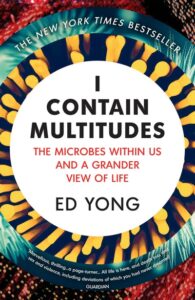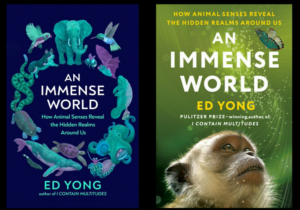 Did you know that many animals experience the world around them much differently than we do? For example, some can “feel” without actually touching something? And others can see colors we cannot? How about the fact that we are all teaming with microscopic organisms that inhabit our skin, inside our bodies and sometimes inside our cells?
Did you know that many animals experience the world around them much differently than we do? For example, some can “feel” without actually touching something? And others can see colors we cannot? How about the fact that we are all teaming with microscopic organisms that inhabit our skin, inside our bodies and sometimes inside our cells?
These are just a few of the fun facts highlighted by Ed Yong in his two fascinating books: I Contain Multitudes and An Immense World: How Animal Senses Reveal the Hidden Realms Around Us. An award-winning science writer for publications such as The Atlantic, National Geographic and Scientific American, Yong is a master at describing the wonders of science in a way that is relatable, enlightening and humorous.
In I Contain Multitudes, he discusses the tiny microbes that make up our microbiome and the power they wield. Although still viewed as unwanted, filthy germs by many people, most are not harbingers of illness. For example, the thousands of microbial species colonizing our guts are typically harmless, important components of our existence, helping us digest food, produce vitamins and break down toxins. Yong manages to weave a rather unnerving topic into an engagingly written book with attention-getting facts, descriptions and explanations. By explaining that microbes help unite us with our fellow creatures, connecting us to each other and the world, also known as symbiosis, his tone is both factual and reassuring.
His follow-up book, An Immense World, explains how animals perceive the world. Spoiler-alert: Their view is often very different than our awareness of it. I came away  thinking of animals as super-heroes with senses such as echolocation (the ability to locate objects by reflected sound), enhanced scent and hearing, touch all over their bodies and the ability to emit electricity, just to name a few. Every animal is encased within their own unique sensory bubble and experiences the world different from other species. This includes living beings from the tiniest insects to humans.
thinking of animals as super-heroes with senses such as echolocation (the ability to locate objects by reflected sound), enhanced scent and hearing, touch all over their bodies and the ability to emit electricity, just to name a few. Every animal is encased within their own unique sensory bubble and experiences the world different from other species. This includes living beings from the tiniest insects to humans.
Yong’s books are must-reads for the curious and science-minded, helping guide us through the mysterious and exciting landscape of what it means being human. I can’t wait to see what he writes about next!
For similar science-themed books at Rutgers, see:
- The song of the cell : an exploration of medicine and the new human by Siddhartha Mukherjee – an exploration of medicine and our radical new ability to manipulate cells.
- The inner life of animals : love, grief, and compassion : surprising observations of a hidden world by Peter Wohlleben – insightful stories into the emotions, feelings, and intelligence of animals around us.
- H is for Hawk by Helen Macdonald – the story of adopting and raising one of nature’s most vicious predators.
- Behave : the biology of humans at our best and worst by Robert M. Sapolsky – an exploration of “Why do we do the things we do?
- The code breaker : Jennifer Doudna, gene editing, and the future of the human race by Walter Issacson – gripping account of how Nobel Prize winner Jennifer Doudna and her colleagues launched CRISPR, a revolution that will allow us to cure diseases, fend off viruses, and have healthier babies.